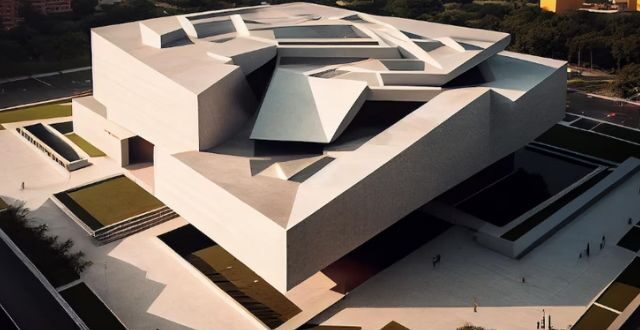Architectural design is a captivating blend of artistry and functionality, where the visions of architects take shape into tangible structures that shape our surroundings. However, conveying these intricate visions to clients and stakeholders can be challenging. This is where architectural renderings emerge as a crucial tool, bridging the gap between concept and reality.
In this article, we delve into the multifaceted role of renderings in the architectural landscape, exploring how they enhance visualization, communication, engagement, and innovation.
Enhancing Visualization with Realistic Renderings
Realistic renderings hold the power to transform architectural concepts into tangible experiences. By meticulously capturing the play of light, the texture of materials, and the intricate details of a design, these renderings provide architects and clients with a vivid glimpse into the future. Imagine standing within a virtual representation of a yet-to-be-built space, where the interplay of sunlight filters through large windows, casting dancing shadows on carefully crafted surfaces.
This level of realism empowers architects to fine-tune their designs, making informed decisions about everything from material choices to spatial arrangements. For clients, the ability to see their future environment with remarkable accuracy ignites a sense of excitement and connection. They can now evaluate how the space aligns with their vision, assess potential modifications, and establish a deeper rapport with the architectural project. This enhanced visualization not only refines design choices but also fosters a shared understanding between architects and clients, nurturing a collaborative journey towards a harmonious end result.
Effective Communication of Design Intent
The challenge of conveying complex architectural ideas often lies in the chasm between an architect’s imagination and a client’s understanding. This is where detailed architectural industrial renderings bridge the gap with eloquence. Renderings speak a universal language that transcends technical jargon and abstract blueprints. Every architectural nuance—from the grandeur of a sweeping staircase to the intricacy of a mosaic-tiled ceiling—comes to life in these graphical representations.
Architects can succinctly communicate their design intent, allowing stakeholders to experience the envisioned space before it’s built. For clients and investors, this clear insight removes uncertainties, ensuring that all parties are aligned on the final product. This communication of design intent isn’t limited to external stakeholders; it also streamlines dialogue within multidisciplinary teams.
Engineers, interior designers, and project managers can all grasp the architectural vision, enabling seamless collaboration and swift decision-making. Renderings serve as powerful mediators, translating complex ideas into accessible visual narratives that resonate with audiences of all backgrounds.
Fostering Client Engagement and Buy-in
In the realm of architecture, capturing hearts and minds is as vital as constructing physical structures. This is precisely where renderings excel, transcending the realm of visuals to evoke emotions and foster deep engagement. A well-executed rendering transforms the abstract into the palpable, igniting the imagination and forming a connection between the viewer and the space.
Clients find themselves stepping into a digital world that mirrors their aspirations, an environment that fuels anticipation and commitment. The rendering becomes a shared language that enables architects and clients to collaborate closely, inviting feedback and co-creation. The immersive experience of navigating through a rendering allows clients to sense the space’s flow, proportions, and ambiance, influencing their preferences and choices.
The emotional resonance sparked by renderings cultivates a sense of ownership, leading to enthusiastic buy-in from the outset. As clients become emotionally invested, their engagement extends beyond a mere project; it transforms into a shared journey towards bringing a visionary design to life.
Early Detection of Design Flaws
Architectural renderings are not just about beauty; they are invaluable tools for precision and efficiency. Before a single brick is laid, renderings provide a virtual playground for architects to meticulously scrutinize every design element. As architects and clients navigate through a digital representation of the space, potential issues that may have remained hidden in traditional blueprints are laid bare.
From spatial inefficiencies to ergonomic challenges, these issues can be identified and rectified at a fraction of the cost and effort compared to modifications during construction. Renderings simulate real-world conditions, enabling architects to gauge factors like traffic flow, lighting variations, and spatial comfort.
The ability to foresee these potential hurdles significantly reduces the risk of expensive rework, ensuring that the final product embodies both aesthetic brilliance and functional excellence. Ultimately, the marriage of design creativity and technical precision within architectural renderings safeguards against design flaws and guarantees a more seamless journey from concept to reality.
Exploring Design Variations
Architecture is an art of endless possibilities, and renderings provide architects with the canvas to explore an array of design variations. These digital landscapes empower architects and clients to experiment with different configurations, materials, and styles, opening doors to innovation and creativity.
The capacity to visualize multiple design scenarios accelerates the decision-making process, as stakeholders can witness the outcomes of various choices. This iterative approach leads to more informed and confident decisions, ensuring that the final design aligns closely with the desired aesthetic and functional goals. As architects fluidly switch between renderings that embody distinct design directions, they engage in a dynamic dialogue with clients.
This dialogue fosters collaboration and strengthens the shared vision, as both parties journey through the intricate dance of refining and perfecting the design. Renderings, in this sense, serve as exploratory vehicles that transform the design process into an evolving narrative, where creativity flourishes and innovation finds its voice.
Marketing and Project Pre-Sales
The role of architectural renderings extends beyond the drawing board; they are powerful tools in the realm of marketing and pre-sales. A captivating rendering offers potential clients and investors a tantalizing glimpse into a future that beckons them to be a part of it. In an era where visual communication reigns supreme, renderings rise as champions, able to encapsulate the essence of a project’s potential. Imagine a rendering that captures a luxury condominium complex, surrounded by lush landscapes and sparkling waters.
Prospective buyers can virtually stroll through elegant interiors and savor sunsets from balconies that are yet to be built. This immersive experience transforms curiosity into desire, and desire into investment. Renderings essentially create a bridge between the present and the future, offering stakeholders an opportunity to emotionally invest in the yet-to-be-realized space. By visually articulating the promise of a project, renderings act as ambassadors, attracting interest, funding, and support in a visually compelling and emotionally resonant manner.
Streamlining Decision-Making Processes
The decision-making process in architecture is a delicate dance of balancing aesthetics, functionality, and feasibility. 3d rendering services become partners in this dance, offering a clear and holistic representation of design choices. Instead of relying solely on abstract blueprints and technical descriptions, stakeholders can now immerse themselves in a rendering that paints a vivid picture of each option.
This immersive experience enhances their ability to evaluate different design paths, fostering efficient and informed decision-making. Renderings not only guide clients and investors but also facilitate alignment within multidisciplinary teams. Engineers can visualize structural elements, interior designers can envision spatial layouts, and planners can assess the project’s integration with its surroundings. As a result, everyone involved gains a shared understanding, leading to a smoother decision-making process that considers diverse perspectives and results in outcomes that harmonize both aesthetically and functionally.
Collaboration and Team Alignment
Architectural projects are collaborative endeavors, where diverse specialists come together to craft an integrated masterpiece. Renderings emerge as a common ground, a visual language that bridges gaps in expertise and perspective.
When an architect presents a rendering to a multidisciplinary team, it’s akin to laying a blueprint that everyone can understand, regardless of their background. This visual reference aligns the team’s collective vision, ensuring that each element works harmoniously towards the overarching goal. Engineers can assess how structural elements interact with spatial design, while interior designers can consider how their concepts enhance the overall ambiance.
This shared understanding nurtures effective teamwork, as every team member contributes not just to their specific area of expertise, but to the holistic success of the project. The rendering becomes a catalyst for collaboration, enabling diverse minds to work cohesively, each contributing their unique insights towards a shared vision.
Educational and Presentational Value
Renderings transcend their role as project documentation; they evolve into dynamic educational tools that offer a glimpse into the intricate world of architectural design. Whether presenting to students, clients, or the general public, renderings provide a relatable entry point into the complexities of architecture. Imagine a lecture hall buzzing with anticipation as an architect walks the audience through a rendering of an iconic structure. The audience is transported to a realm where design principles, spatial layouts, and aesthetic considerations are illustrated in real-time.
Concepts that would be difficult to convey through words or static images come to life, making architectural theory accessible and engaging. Renderings also enhance presentations to clients, transforming abstract plans into captivating narratives that resonate emotionally. As architects use renderings to illustrate their design rationale, clients can see the thought process behind each decision, leading to a more informed and confident collaboration. In essence, renderings serve as educational beacons that illuminate the intricate world of architecture, making it accessible and inspiring to all.
Technological Advances in Architectural Rendering
As technology races forward, architectural renderings are undergoing a transformative revolution. The integration of virtual reality (VR), augmented reality (AR), and real-time rendering has fundamentally altered the way we experience architectural design. VR allows clients to don headsets and virtually step into their future spaces, immersing themselves in an environment that is yet to be built. AR overlays digital elements onto the physical world, facilitating real-time interactions with proposed design changes.
Real-time rendering takes viewers on a journey where they can dynamically alter lighting conditions, materials, and even design elements, observing the impact instantly. These technological advancements are not just gimmicks; they redefine engagement and participation. Clients and stakeholders are no longer passive observers; they are active participants in shaping the design evolution.
The democratization of design interaction, enabled by these technologies, brings architecture closer to the human experience, making it intuitive, exciting, and deeply personal. As architects explore these frontiers, they’re not just creating buildings; they’re crafting experiences that transcend the realm of the virtual and redefine the boundaries of design possibilities.
Conclusion
Architectural renderings are more than just visual representations; they are portals into a world of innovation, collaboration, and communication. As architects, clients, and stakeholders step into these virtual realms, they embark on a journey that transcends physical limitations, unlocking a cascade of benefits.
Renderings enhance visualization, allowing architects to fine-tune designs and clients to intimately connect with their future spaces. They communicate design intent with eloquence, bridging gaps between creators and decision-makers. Renderings foster engagement and commitment, transforming viewers into active participants in the design journey.
They unveil design flaws early, saving resources and elevating project quality. Renderings encourage exploration and innovation, opening doors to creative design variations. They serve as marketing ambassadors, attracting investment and support. Renderings streamline decision-making, ensuring alignment across multidisciplinary teams.
They facilitate collaboration, offering a shared visual language. Renderings educate, making architectural complexities relatable and inspiring. Lastly, they embrace technological progress, reshaping how we experience architectural design. In the end, architectural renderings are not just tools; they are the heartbeat of a transformative industry, propelling architecture into a future where design is as much about experiences as it is about structures.
 khamush.com Lifestyle | Motivation | Poems
khamush.com Lifestyle | Motivation | Poems




